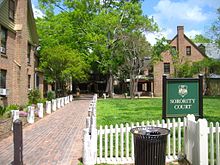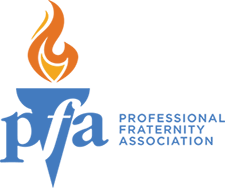The College of William & Mary fraternities and sororities include chapters of national organizations belonging to the Panhellenic Council, the Interfraternity Council (IFC) and the National Pan-Hellenic Council, and also recognizes one local fraternity without Greek letters ( Queens' Guard) and the local chapter of one national fraternity (Kappa Sigma) that abandoned membership in an inter-Greek consortium. [1] The school also offers a variety of honor and co-ed service fraternities as well. The first collegiate fraternity within the present borders of the United States, the Latin-letter F.H.C. Society, was founded at the College of William & Mary on November 11, 1750. The new country's first Greek-letter fraternity was founded at the College on December 5, 1776. However, the Phi Beta Kappa Society is no longer a social fraternity but is now the leading American academic honor society. Some fraternities and sororities are limited to graduate students at William & Mary, while others may only be joined at the undergraduate level. Still, other Greek-letter organizations operate without recognition or approval from college administrators. [2] [3]
Contents
- NAIC social fraternities
- Active fraternities
- Suspended or inactive fraternities
- Panhellenic social sororities
- National Pan-Hellenic Council fraternities and sororities
- Multicultural Greek Council fraternities and sororities
- Honor and service fraternities and sororities
- Notes
- References
- External links
Two social fraternities were established at William & Mary before the Civil War: Theta Delta Chi in 1853 and Sigma Alpha Epsilon in 1857. By the turn of the twentieth century there were seven social fraternities [4] and by 1940 a total of 14 fraternity chapters and nine sorority chapters had been established at the College. [5] Photographs in early twentieth century volumes of the Colonial Echo illustrate the variety of houses around Williamsburg used by these organizations, including several houses later incorporated into the Restored Area of Colonial Williamsburg. By 1925 there was an early fraternity row on Jamestown Road with Theta Delta Chi at #216, Sigma Nu at #234, Sigma Alpha Epsilon at #308, and Kappa Sigma at #312.
Between 1927 and 1931 a collection of brick houses was built to house the sororities on the first block of Richmond Road, across from the President's House. Five nearly identical houses face a mid-block interior courtyard and four additional houses front Richmond Road.
By 1940 the College Terrace neighborhood adjacent to campus hosted six large fraternity houses: Sigma Nu (later Phi Kappa Tau) at 601 College Terrace, Sigma Phi Epsilon (#415), Theta Delta Chi (#606), Lambda Chi Alpha (#607), and Kappa Sigma (#700) on Richmond Road, and Kappa Alpha in what is today part of the Alumni House at 500 Richmond Road. For many years Pi Lambda Phi was housed at 230 Griffin Avenue, Pi Kappa Alpha at 205 Richmond Road, and Sigma Pi in the southern annex of Reves Hall. World War II decimated male student enrollment and challenged fraternity operations. In 1943 the College forced all fraternities to surrender their houses to help address a war-related housing shortage.
Male enrollment rebounded after the war and the surviving fraternities petitioned the College to provide meeting spaces to support the social organizations. In 1948 eleven small lodges were constructed in the woods on the then-western edge of campus for this purpose. The lodges were subsequently used for faculty offices and upperclassmen housing.
By the 1960s the College desperately needed additional housing and the fraternities had outgrown the lodges. Two residential complexes were built in the woods on the then-western edge of campus for Greek organizations. Both were designed as dormitories with large meeting rooms and outdoor terraces. The Fraternity Complex opened in 1968 comprising three buildings containing a total of twelve semi-detached "houses" or units. These buildings have now been converted into freshman dormitories known as the Green and Gold Village. What is now known as the Botetourt Complex opened in 1973 with the intention to relocate the women's organizations from Sorority Court. Comprising five buildings containing nine units the complex never hosted sororities.

At the end of the 2007–08 academic calendar year, 25% of undergraduate men and 27% of undergraduate women participated in the Greek system. [1] The average fraternity size was 38 members, while the average sorority size was seventy members. [1]
In the Autumn of 2013, eleven new fraternity houses and a Greek community center were opened. Each of the new houses accommodates seventeen men. [6] After the new fraternity buildings were opened, Delta Phi acquired one of the eleven new fraternity houses, and Alpha Epsilon Pi took over Delta Phi's old house on Armistead Avenue.



